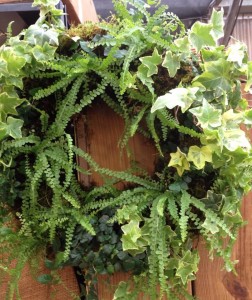
A living wreath planted for shade using houseplant ferns, creeping fig and ivy…
This post is for all you do-it-yourselfers and those that just like to know how interesting plantings are created. Living wreaths are one of those things, or, as I like to think of them, the original vertical garden arrangement. Maybe you’ve seen them on Pinterest or at your favorite garden shop (Of course, if you’re in Birmingham, we hope that’s us!).
Living wreaths are not difficult to make and are really quite fun – it just takes some time and a little thought choosing plants. The first step is deciding where you’d like to have your living wreath. Perhaps you have a gate leading into your garden? Or maybe there’s a blank spot on that shady patio wall? They also work well placed on a flat surface such as a table.
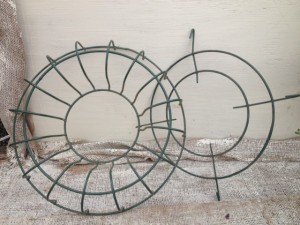
The sturdy wreath form you see here is a standard plastic coated 16″ size. You can see there are two pieces, and the smaller back piece hooks easily onto the larger one.
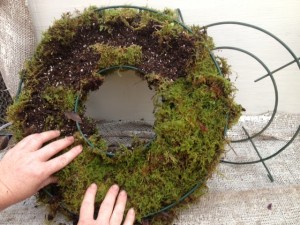
Lining the form prior to planting…
Many how-tos for living wreaths use moistened sphagnum moss to line the form. We plant them a bit differently, lining the form with moistened green sheet moss, then filling the cavity with potting soil and slow release fertilizer before planting. We’ve been planting hayracks, moss baskets and wreaths like this for over 20 years in this manner.
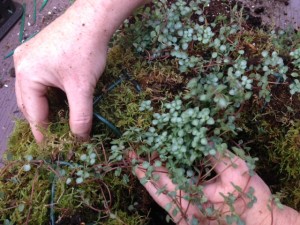
insert plants at intervals through the moss, firming in.
Jamie designed the wreath in this demonstration for a customer who wanted an interesting mix of foliage for use in a bright location. Her plant material includes pilea, tillandsias, tiny pink cryptanthus, and baby tears. It’s important to understand the cultural needs of the plants being used so any special watering needs can be met. In this composition, the baby tears will need special attention as they require the most water.
As with any open wired container that is being lined, don’t skimp on the moss. It’s the glue that’s holding everything together after all. When the form is thickly lined, add the potting soil, moistening it and firming it in, then add a slow release fertilizer like Osmocote. Remember to always use a good quality soilless mix when planting any type of container. After the cavity is filled, add more sheet moss to the “back” of the wreath and attach the smaller piece. Now your wreath form is ready to plant!
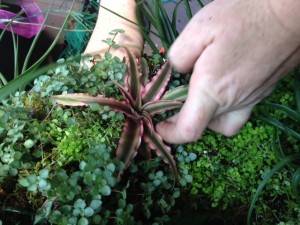
Adding the cryptanthus…
Water your plants well, then insert them into the wreath by pushing a hole into the moss with your fingers so the soilless mix is exposed. Of course, the smaller the plant the easier this step will be. Once the plant is firmed into place add more sheet moss if needed to keep the soil around the root ball of the plant.
Some plants can be purchased in larger pots and pulled apart, like the pilea and baby tears shown here. It may look a little messy at first, but they will recover in no time. Many plants that work well in living wreaths can be separated in this manner, including ivy, creeping fig, fittonia, asparagus fern, creeping jenny, dwarf mondo, some small ferns and many succulents.
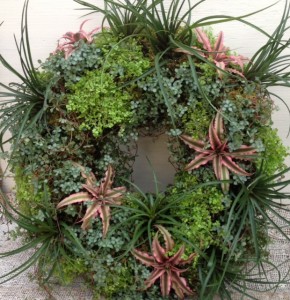
Finished!
What makes these wreaths so interesting and fun to make is the use of different foliage colors, textures and shapes. But, in addition to foliage, wreaths like those shown here can also be planted with bedding plants – in the spring begonias work well and, in the fall, violas and pansys make lovely wreaths too.
Watering requirements will vary on living wreaths, depending on the plants used. For instance, a wreath planted with succulents will need less attention than those shown here.
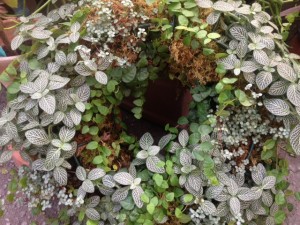
a living wreath for shade with fittonia, creeping fig and pilea
We’ve found the easiest watering method is to lay them flat and either pour water on them or let them sit in a saucer of water until the planting is heavy. The ivy, fern and creeping fig wreath shown at the beginning of this post lived in the greenhouse, so we were able to shower it with the hose when it needed watering, and the ivy and creeping fig was periodically pinned to the wreath with florist wire so it could root into the moss.
So, as you can see, it just takes time, the proper plants and the right technique to make a living wreath – try one for yourself!
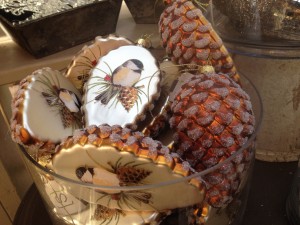
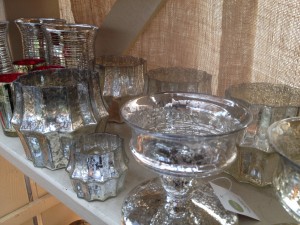
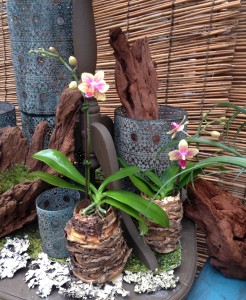
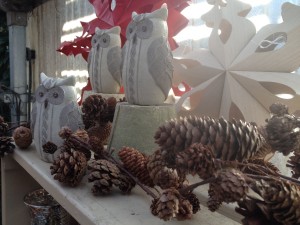
 I hope you have the opportunity to visit, as the greenhouse is a visual feast for the senses, awash in all the colors and scents of the season….
I hope you have the opportunity to visit, as the greenhouse is a visual feast for the senses, awash in all the colors and scents of the season….
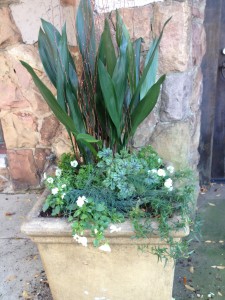
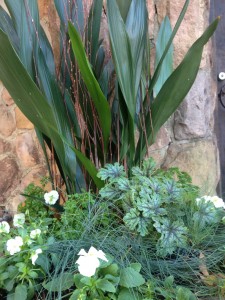 The emphasis is on foliage, though, and I’ve included curly parsley for it’s fresh green color, a small blue fescue grass, and a shade loving heuchera for this planting. Holdovers from the summer are aspidistra, which I thin out each season, and a tiny leaf green ivy. After planting, I added birch branches to add more height and winter interest. (Branches are an easy way to get color in planters during the holiday – red twig dogwood branches would also be pretty.) While it looks a bit top heavy with the tall aspidistra at first, the parsley and heuchera will add fullness to the composition as it grows in. I’m also trying the Cool Wave white trailing pansies here this year, hoping they get enough sun to bloom well.
The emphasis is on foliage, though, and I’ve included curly parsley for it’s fresh green color, a small blue fescue grass, and a shade loving heuchera for this planting. Holdovers from the summer are aspidistra, which I thin out each season, and a tiny leaf green ivy. After planting, I added birch branches to add more height and winter interest. (Branches are an easy way to get color in planters during the holiday – red twig dogwood branches would also be pretty.) While it looks a bit top heavy with the tall aspidistra at first, the parsley and heuchera will add fullness to the composition as it grows in. I’m also trying the Cool Wave white trailing pansies here this year, hoping they get enough sun to bloom well.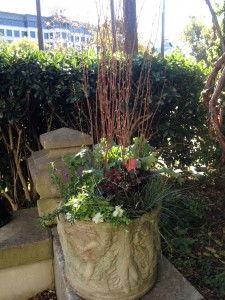
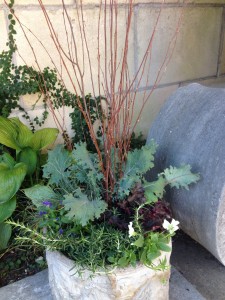 This fall Pardis asked if I would also take a look at the planters at Bottega, their other wonderful restaurant.
This fall Pardis asked if I would also take a look at the planters at Bottega, their other wonderful restaurant.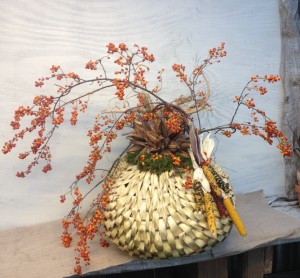 Autumn inspires us! The past month we’ve been designing with thoughts of fall…a copper container, a beautiful basket, a heavy stone trough, and even something as simple as a wooden box made wonderful starting pieces for a few of them.
Autumn inspires us! The past month we’ve been designing with thoughts of fall…a copper container, a beautiful basket, a heavy stone trough, and even something as simple as a wooden box made wonderful starting pieces for a few of them.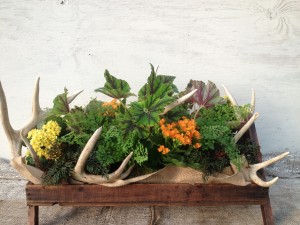 This wooden box arrangement was done for a garden club – the customer brought in the antlers! This one was a fun change of pace. Those antlers didn’t want to stay put, and the box was a tad rickety…it reminds us that each day may bring different and interesting challenges!
This wooden box arrangement was done for a garden club – the customer brought in the antlers! This one was a fun change of pace. Those antlers didn’t want to stay put, and the box was a tad rickety…it reminds us that each day may bring different and interesting challenges!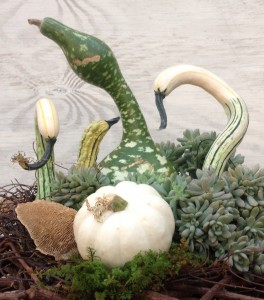
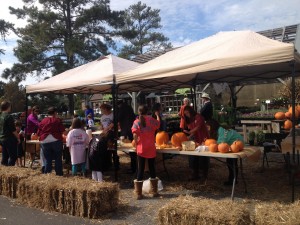
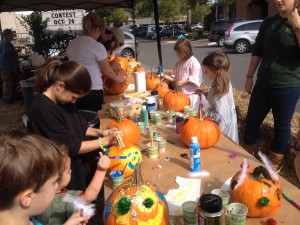

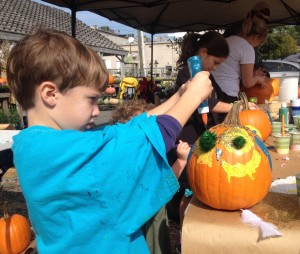
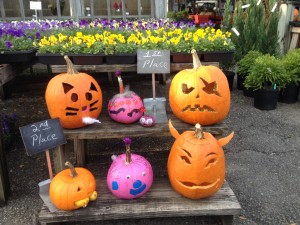
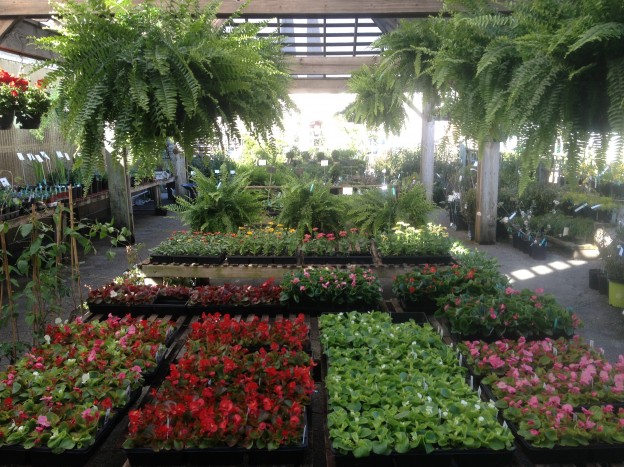
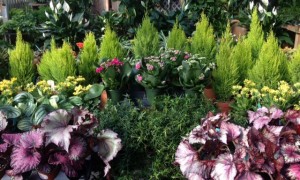
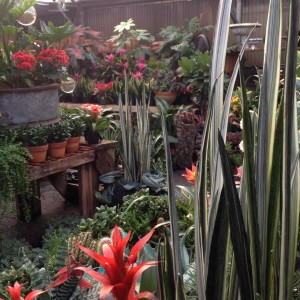 But there’s also another important point coming to light because of this online article. It seems some people think buying “local” includes large national chains that are anything but local, though they might be right down the road.
But there’s also another important point coming to light because of this online article. It seems some people think buying “local” includes large national chains that are anything but local, though they might be right down the road. I’m usually the last person anyone wants to ask about apps for personal devices, but this one is definitely special. Dr. Allan Armitage is well known in horticultural circles as being the authority on annuals and perennials, and developed and maintains the Trial Gardens at UGA where new plants from throughout the world are evaluated for heat and humidity performance. His bio is extensive, and you can take a look at it on the app, but suffice it to say he’s received many, many awards for teaching, writing and research.
I’m usually the last person anyone wants to ask about apps for personal devices, but this one is definitely special. Dr. Allan Armitage is well known in horticultural circles as being the authority on annuals and perennials, and developed and maintains the Trial Gardens at UGA where new plants from throughout the world are evaluated for heat and humidity performance. His bio is extensive, and you can take a look at it on the app, but suffice it to say he’s received many, many awards for teaching, writing and research.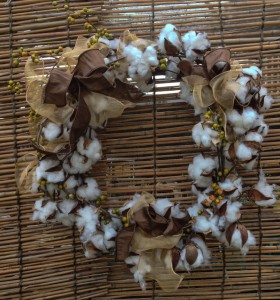 We look forward to fall with its autumn hues glowing on gorgeous
We look forward to fall with its autumn hues glowing on gorgeous 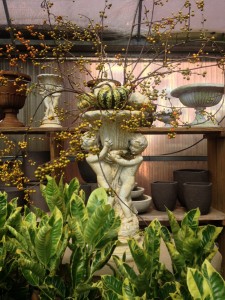 Bittersweet, arranged in a classic urn, gives us the quintessential look of fall. This piece is quite large, but the same effect can be achieved in a simple vase just as easily. I used dry foam with moss and added gourds to complete the arrangement.
Bittersweet, arranged in a classic urn, gives us the quintessential look of fall. This piece is quite large, but the same effect can be achieved in a simple vase just as easily. I used dry foam with moss and added gourds to complete the arrangement.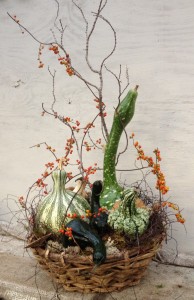 Swan gourds here are grouped in a basket lined with moss and angel vine. If you let your imagination go, you might see an aviary family under the branch of a tree. Or, you might just see a natural composition encircled and overhung by bittersweet. There’s no wrong way to interpret this!
Swan gourds here are grouped in a basket lined with moss and angel vine. If you let your imagination go, you might see an aviary family under the branch of a tree. Or, you might just see a natural composition encircled and overhung by bittersweet. There’s no wrong way to interpret this!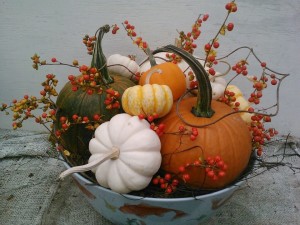
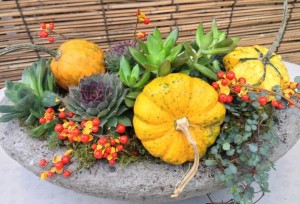
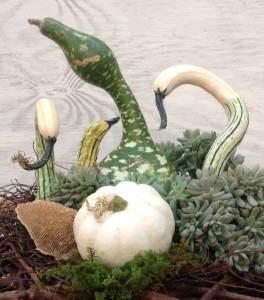
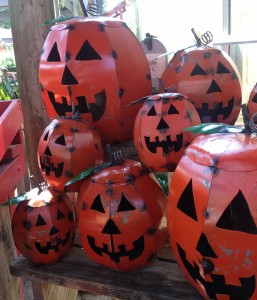 Halloween will be here soon, and Saturday, October 26th, we’re having a
Halloween will be here soon, and Saturday, October 26th, we’re having a 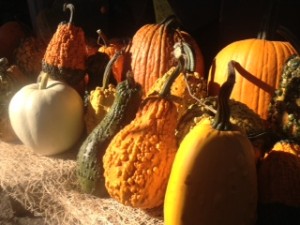
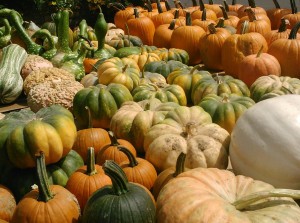
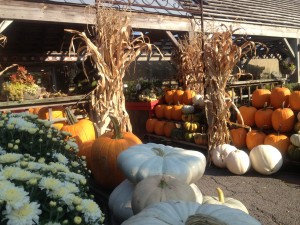

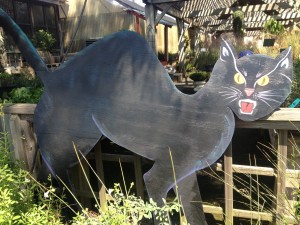
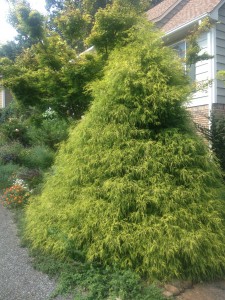
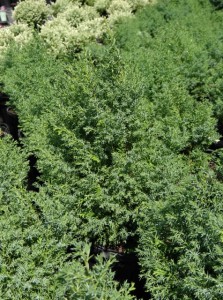
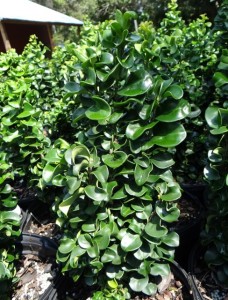
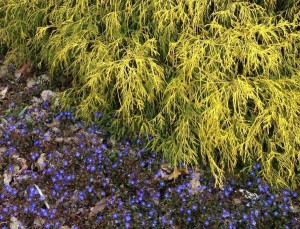
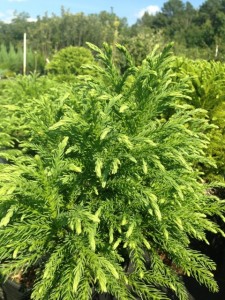
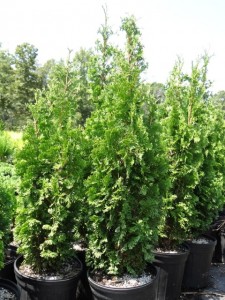
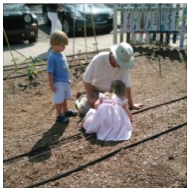
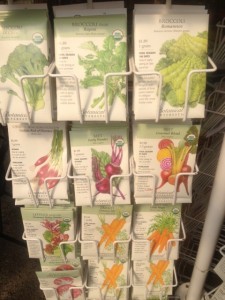
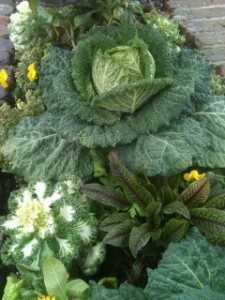
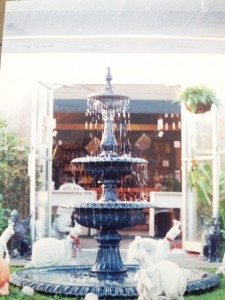
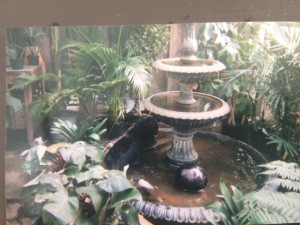
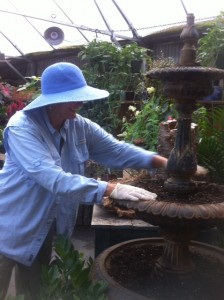
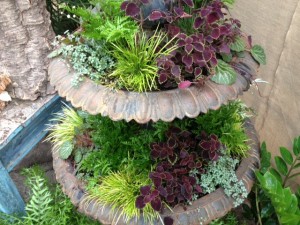
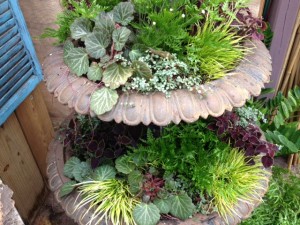
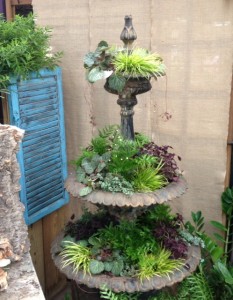 One of the filler plants I used was a tiny grass, Acorus minimus – all the acorus love moisture so it should do well. I rounded out the filler plants with a few ferns and another bog plant called Syngonanthus chrysanthus ‘Mikado’. This is a definite test since we know next to nothing about this plant; however, the fountain basin should give it the boggy conditions it is supposed to prefer!
One of the filler plants I used was a tiny grass, Acorus minimus – all the acorus love moisture so it should do well. I rounded out the filler plants with a few ferns and another bog plant called Syngonanthus chrysanthus ‘Mikado’. This is a definite test since we know next to nothing about this plant; however, the fountain basin should give it the boggy conditions it is supposed to prefer!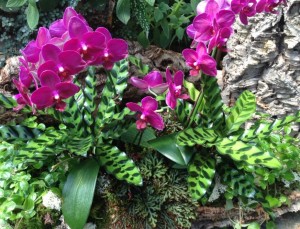 This summer’s wet, cool weather might have kept many of you out of your gardens, but we’ve managed to stay busy in the greenhouse putting together arrangements filled with orchids, succulents, houseplants, and so much more…here’s a peek at some of them. We regularly have folks who stop in just to see what we’ve been working on! All of these arrangements are composed of live plants, no cut flowers here.
This summer’s wet, cool weather might have kept many of you out of your gardens, but we’ve managed to stay busy in the greenhouse putting together arrangements filled with orchids, succulents, houseplants, and so much more…here’s a peek at some of them. We regularly have folks who stop in just to see what we’ve been working on! All of these arrangements are composed of live plants, no cut flowers here.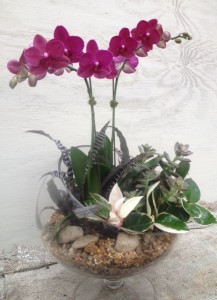
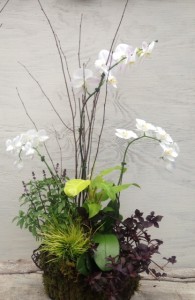
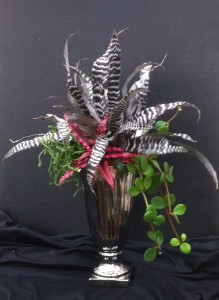 Finally, the silver container was given in memory of someone…the longlasting and low maintenance houseplants of trailiing pepperomia and cryptanthus make excellent companions. It’s gratifying, also, to know that whoever is on the receiving end will be able to enjoy this longer than a fresh flower arrangement could ever hope to last.
Finally, the silver container was given in memory of someone…the longlasting and low maintenance houseplants of trailiing pepperomia and cryptanthus make excellent companions. It’s gratifying, also, to know that whoever is on the receiving end will be able to enjoy this longer than a fresh flower arrangement could ever hope to last.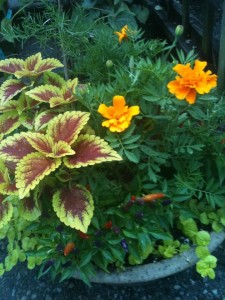 I’m not quite sure I’ve been living in the Southeast this summer…plentiful rain and decent temperatures – (Though it looks like the heat is finally returning.) this has been Alabama in August?!
I’m not quite sure I’ve been living in the Southeast this summer…plentiful rain and decent temperatures – (Though it looks like the heat is finally returning.) this has been Alabama in August?!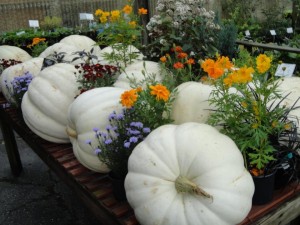
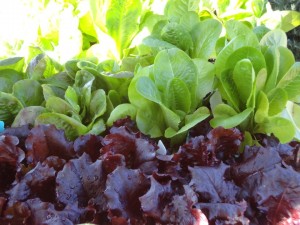 But, if your garden and beds are struggling…think about where you’d like to see marigolds, ornamental peppers, late season salvias, and, further down the road, lettuce, asters and cool season herbs – we’ll have transplants of parsley, thyme (Look for the lemon variegated thyme which looks beautiful with green or red lettuce and marigolds.) dill and cilantro too.
But, if your garden and beds are struggling…think about where you’d like to see marigolds, ornamental peppers, late season salvias, and, further down the road, lettuce, asters and cool season herbs – we’ll have transplants of parsley, thyme (Look for the lemon variegated thyme which looks beautiful with green or red lettuce and marigolds.) dill and cilantro too.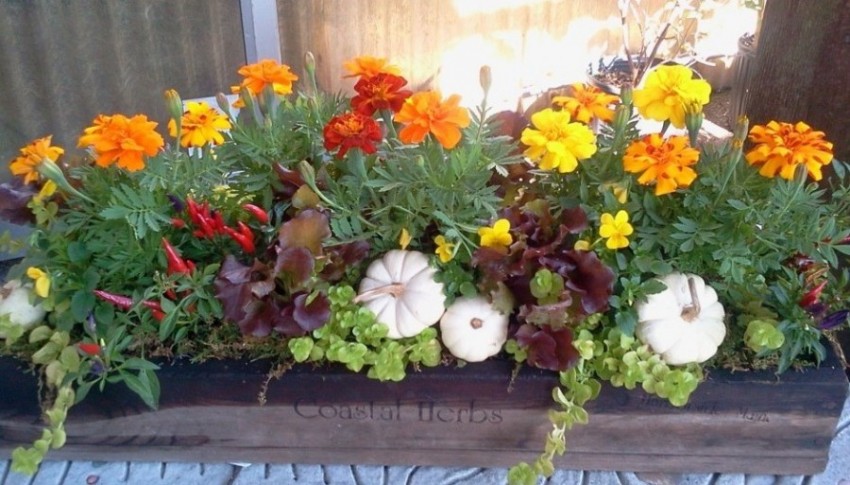
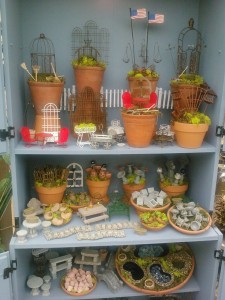 For all of you
For all of you 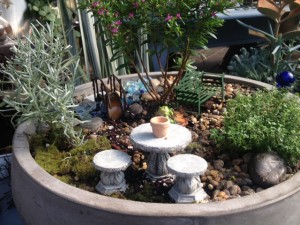
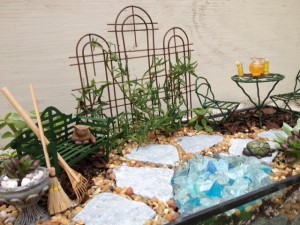 Some people have asked why we don’t carry fairies and other inhabitants for our miniature gardens. For us, the garden is the key – creating a miniature garden world with plants that actually will grow for you…along with some judicious clipping when needed. (Fairies are there in spirit, not seen, and, if the garden has the magic of the creator’s touch, of course they’ll come.)
Some people have asked why we don’t carry fairies and other inhabitants for our miniature gardens. For us, the garden is the key – creating a miniature garden world with plants that actually will grow for you…along with some judicious clipping when needed. (Fairies are there in spirit, not seen, and, if the garden has the magic of the creator’s touch, of course they’ll come.)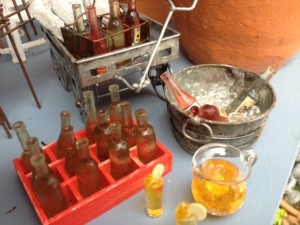 These miniature gardens have really struck a chord for adults and kids alike, and it’s so much fun to see the delight by adults and excitement of little ones as they browse (and play with) the tiny creations that can be used in their own gardens. Of course, any activity that stimulates imagination is certainly worthwhile! For children, it’s a make believe world; for adults it’s an outlet to grow plants in a different way.
These miniature gardens have really struck a chord for adults and kids alike, and it’s so much fun to see the delight by adults and excitement of little ones as they browse (and play with) the tiny creations that can be used in their own gardens. Of course, any activity that stimulates imagination is certainly worthwhile! For children, it’s a make believe world; for adults it’s an outlet to grow plants in a different way.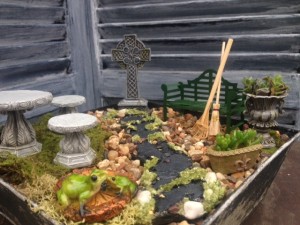 All was well until the night the little girl had a sleepover party with a couple of her friends…you might well imagine where this story is going! Somehow the miniature garden, which she kept in her bedroom, was completely up-ended in the middle of the bed, an utter mishmash of soil, plants,pea gravel, stones and little accessories. It must have been like Humpty Dumpty falling off the wall in the fairytale! We helped rework the little miniature garden, and hopefully that little girl is still happily raking her pea gravel “path”…
All was well until the night the little girl had a sleepover party with a couple of her friends…you might well imagine where this story is going! Somehow the miniature garden, which she kept in her bedroom, was completely up-ended in the middle of the bed, an utter mishmash of soil, plants,pea gravel, stones and little accessories. It must have been like Humpty Dumpty falling off the wall in the fairytale! We helped rework the little miniature garden, and hopefully that little girl is still happily raking her pea gravel “path”…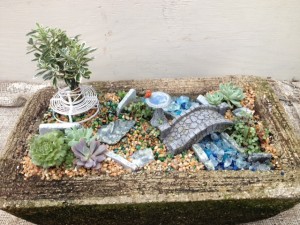 Not long ago a parent, her daughter, and the girl’s little brother came in. The mother marched to the counter with the little boy and said that he needed to buy, with his own money, a stone for his sister’s miniature garden. Puzzled, I asked what kind of stone he needed. Well, the mother said, her daughter had a stone with the words “My Garden” written on it in her miniature garden. Evidently the little boy had turned it around and scrawled “bathroom” on the back! Of course, the boy’s sister wasn’t having any of that in her garden. So, we found the perfect stone, wrote “My Garden” on it for the little girl, and the little boy brought out his money to pay for it. Before they left, the mother gave the little boy the stone that he’d written on. Much later we found it hidden in the miniature garden displays and had a good laugh….he didn’t want it either!
Not long ago a parent, her daughter, and the girl’s little brother came in. The mother marched to the counter with the little boy and said that he needed to buy, with his own money, a stone for his sister’s miniature garden. Puzzled, I asked what kind of stone he needed. Well, the mother said, her daughter had a stone with the words “My Garden” written on it in her miniature garden. Evidently the little boy had turned it around and scrawled “bathroom” on the back! Of course, the boy’s sister wasn’t having any of that in her garden. So, we found the perfect stone, wrote “My Garden” on it for the little girl, and the little boy brought out his money to pay for it. Before they left, the mother gave the little boy the stone that he’d written on. Much later we found it hidden in the miniature garden displays and had a good laugh….he didn’t want it either!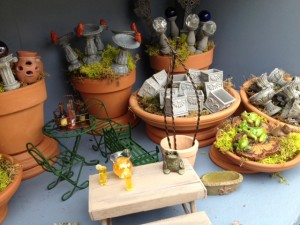 Some of the fun things we’ve gotten in recently include a pair of ghosts (It’s never too early to begin thinking about Halloween!), wooden soda bottle crates with soda bottles, a wine basket with wine bottles, a metal tub (just right to put the wine and soda bottles in!), tiny turtles, frogs and one very fat cat, some pretty urns, a very realistic Celtic cross, a stone walking bridge, a triple trellis and more. And there will be additional miniature garden items coming in down the road too. It’s a good idea to pop in every now and then to see what’s new.
Some of the fun things we’ve gotten in recently include a pair of ghosts (It’s never too early to begin thinking about Halloween!), wooden soda bottle crates with soda bottles, a wine basket with wine bottles, a metal tub (just right to put the wine and soda bottles in!), tiny turtles, frogs and one very fat cat, some pretty urns, a very realistic Celtic cross, a stone walking bridge, a triple trellis and more. And there will be additional miniature garden items coming in down the road too. It’s a good idea to pop in every now and then to see what’s new.






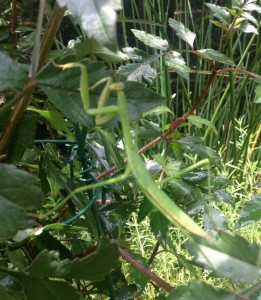 This post is all about relaxing in your garden. Yes, I said relaxing…it’s late summer and the garden is buzzing with life – or should be. Hopefully we’ve helped you create the perfect habitat for beneficial and beautiful insects and other critters. Take a stroll every so often and really see all that’s happening in their home.
This post is all about relaxing in your garden. Yes, I said relaxing…it’s late summer and the garden is buzzing with life – or should be. Hopefully we’ve helped you create the perfect habitat for beneficial and beautiful insects and other critters. Take a stroll every so often and really see all that’s happening in their home.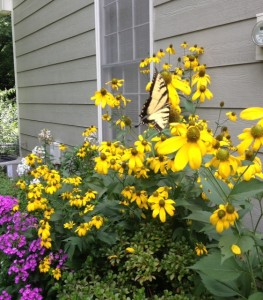
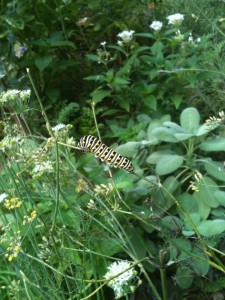 I’ve also seen a few swallowtail butterflies – graceful beacons of midsummer, moving from pentas to zinnia to dahlia and back -.and one that had somehow torn its wing and that I found the next day in tatters in one of my beds. The circle of life continues…
I’ve also seen a few swallowtail butterflies – graceful beacons of midsummer, moving from pentas to zinnia to dahlia and back -.and one that had somehow torn its wing and that I found the next day in tatters in one of my beds. The circle of life continues…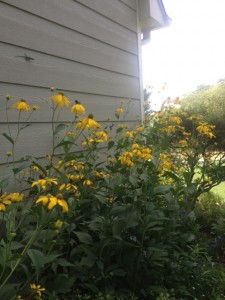
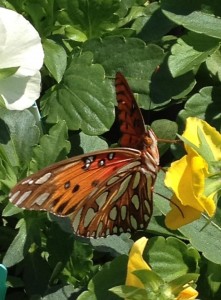
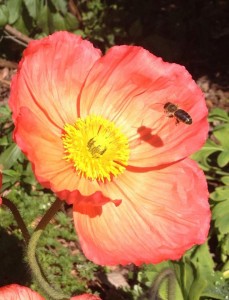 I somehow captured the most perfect shot of a honeybee going in for a landing on a poppy this past spring. We need to be mindful of the bees…I’m thankful when I see them happily moving from one bloom to another on the vitex in June or the salvias in August.
I somehow captured the most perfect shot of a honeybee going in for a landing on a poppy this past spring. We need to be mindful of the bees…I’m thankful when I see them happily moving from one bloom to another on the vitex in June or the salvias in August.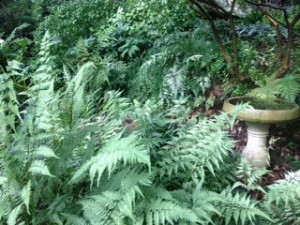 With 2013 beginning with a wet, cool spring and the rain continuing into early summer, it seemed like we’d been transported into a different universe than Alabama, didn’t it? All the rain may have caused some complacency – everything seems so much lusher than it usually is this time of year…now the heat is here, though, and it seems certain we’ll be entering our usual summer pattern of hit and miss rain showers with lots of warmth and humidity…
With 2013 beginning with a wet, cool spring and the rain continuing into early summer, it seemed like we’d been transported into a different universe than Alabama, didn’t it? All the rain may have caused some complacency – everything seems so much lusher than it usually is this time of year…now the heat is here, though, and it seems certain we’ll be entering our usual summer pattern of hit and miss rain showers with lots of warmth and humidity…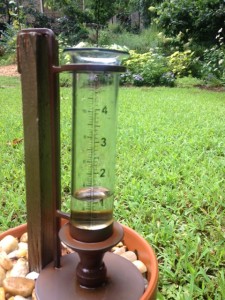 Established plantings in your landscape should be doing well, but be aware that new plantings of shrubs, trees and perennials will need supplemental watering this first summer – pay attention to them. The requirement for new plantings is an inch of water each week.
Established plantings in your landscape should be doing well, but be aware that new plantings of shrubs, trees and perennials will need supplemental watering this first summer – pay attention to them. The requirement for new plantings is an inch of water each week.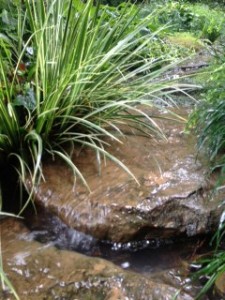
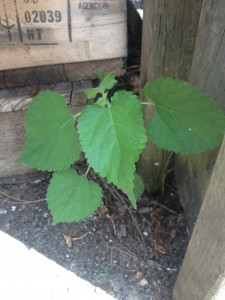 Mulberry weed, Fatuoua villosa, is a weed you definitely want to get rid of if you ever see it in your flower beds or any part of your landscape. Another common name is hairy crab weed – that doesn’t sound very pleasant does it? I cuss this weed out every time I see one (or more) in my garden…the main problem with this noxious weed is that it spreads by seed…and the seeds occur on very tiny plants. In my research, I keep finding that maintaining a 2″-4″ layer of mulch will help smother germinating seeds, and that pre and post emergent herbicides are very effective. Hower, because it grows so closely among desirable plants, using herbicides can be problematic, and not my favorite solution anyway.
Mulberry weed, Fatuoua villosa, is a weed you definitely want to get rid of if you ever see it in your flower beds or any part of your landscape. Another common name is hairy crab weed – that doesn’t sound very pleasant does it? I cuss this weed out every time I see one (or more) in my garden…the main problem with this noxious weed is that it spreads by seed…and the seeds occur on very tiny plants. In my research, I keep finding that maintaining a 2″-4″ layer of mulch will help smother germinating seeds, and that pre and post emergent herbicides are very effective. Hower, because it grows so closely among desirable plants, using herbicides can be problematic, and not my favorite solution anyway.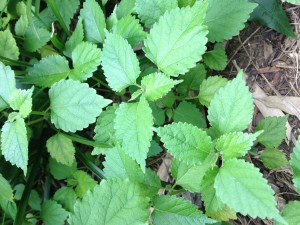
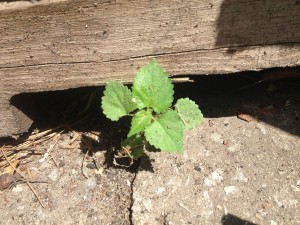 Listed as a noxious and invasive weed, it gets it’s common name because it looks similar to mulberry tree seedlings when they’re 4″ tall…but this herbaceous weed has a taproot and can grow 3′-4′ tall. You never, ever want them to get to that point though!!!! It has purplish green flowers with no petals, and the seeds, which appear on it when it’s not even 2″ tall, are explosively discharged up to 4′ from the original plant. Because of this, there is never just one of this weed, but more likely, colonies of it. It’s easy to pull when young, but because it develops a taproot, it becomes more difficult to pull as the plant gets larger. Be vigilant in eradicating this weed, and dispose of any that you hand pull into a trash bag immediately – don’t ever put it in your compost pile.
Listed as a noxious and invasive weed, it gets it’s common name because it looks similar to mulberry tree seedlings when they’re 4″ tall…but this herbaceous weed has a taproot and can grow 3′-4′ tall. You never, ever want them to get to that point though!!!! It has purplish green flowers with no petals, and the seeds, which appear on it when it’s not even 2″ tall, are explosively discharged up to 4′ from the original plant. Because of this, there is never just one of this weed, but more likely, colonies of it. It’s easy to pull when young, but because it develops a taproot, it becomes more difficult to pull as the plant gets larger. Be vigilant in eradicating this weed, and dispose of any that you hand pull into a trash bag immediately – don’t ever put it in your compost pile.